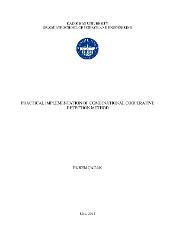| dc.contributor.advisor | Küçük, Serhat | en_US |
| dc.contributor.author | Çatak, Evren | |
| dc.date.accessioned | 2019-07-12T08:36:09Z | en_US |
| dc.date.available | 2019-07-12T08:36:09Z | en_US |
| dc.date.issued | 2012 | en_US |
| dc.identifier.uri | https://hdl.handle.net/20.500.12469/1990 | |
| dc.description.abstract | in conventional cooperative detection a fusion center decides on the presence or theabsence of the primary user by gathering all the information from the secondaryusers (SUs) and conveys this decision to all users. This approach does not take intoaccount the locations of the SUs where a user far from the primary user (PU) mayalso have to keep silent. An alternative method referred to as the combinationalcooperative detection method in this study was recently proposed to solve thisproblem. This method is based on combining received signals from more than twousers obtaining decision tables and deciding individually for each user. While theproposed method showed promising results for the secondary users there wereunclear issues regarding the practical implementation of this method. These issuesinclude the effect of the location and the distribution of the SUs as well asdetermining the conventional cooperative detection performance as a benchmark. | en_US |
| dc.description.abstract | Klasik işbirlikli algılama yönteminde, füzyon merkezi ikincil kullanıcılardan gelen sinyalleri işleyerek birincil kullanıcının aktif olup olmadığına karar verir ve bu bilgiyi tüm kullanıcılara iletir. Bu yaklaşımda ikincil kullanıcı konumları dikkate alınmadığı için birincil kullanıcıya girişim yaratmayacak uzaklıktaki bir kullanıcı iletişime geçmeyecektir. Bu sorunun üstesinden gelmek için daha önce kombinasyonel işbirlikli algılama yöntemi olarak adlandırılan bir yöntem önerilmiştir. Bu yöntemde ikiden fazla ikincil kullanıcının algıladığı sinyallerin kombinasyonlarına göre karar tabloları oluşturularak her bir kullanıcı için karar verilmektedir. Önerilen bu yöntemle, ikincil kullanıcılar için iyileşmiş sonuçlar elde edilse de pratik uygulamasına ilişkin konular açık değildir. Kullanıcı konum ve dağılımları ile karşılaştırma ölçütü olarak alınan işbirlikli algılama yöntem performansı bu konulardan önemli olanlarıdır. Bu eksikliklerden yola çıkarak, kombinasyonel işbirlikli algılama yöntemin pratik gerçekleştirimi incelenmiştir. Buna göre, bu tezde (i) sistem parametrelerine göre ikincil kullanıcıların ve dağılımlarının etkisi incelenmiş, (ii) karşılaştırma ölçütü olan işbirlikli algılama performansı doğru tanımlanmış, ve (iii) yeni geliştirilen yöntemle kombinasyonel işbirlikli algılama yöntemi hata oranları iyileştirilmiş ve başarılan hata olasılıklarının niceliği belirlenmiştir. Bu çalışma, hangi durumlarda kombinasyonlu işbirlikli algılama yönteminin, geleneksel işbirlikli algılama yöntemine tercih edilmesi gerektiği konusunda önemli sonuçlar vermektedir. | en_US |
| dc.language.iso | eng | en_US |
| dc.publisher | Kadir Has Üniversitesi | en_US |
| dc.rights | info:eu-repo/semantics/openAccess | en_US |
| dc.subject | Bilişsel radyo | en_US |
| dc.subject | İşbirlikli algılama | en_US |
| dc.subject | Enerji algılama | en_US |
| dc.subject | Spektrum sezme | en_US |
| dc.title | Practical implementation of combinational cooperative detection method | en_US |
| dc.type | masterThesis | en_US |
| dc.department | Enstitüler, Lisansüstü Eğitim Enstitüsü, Elektronik Mühendisliği Ana Bilim Dalı | en_US |
| dc.relation.publicationcategory | Tez | en_US |
| dc.identifier.yoktezid | 312886 | en_US |
















